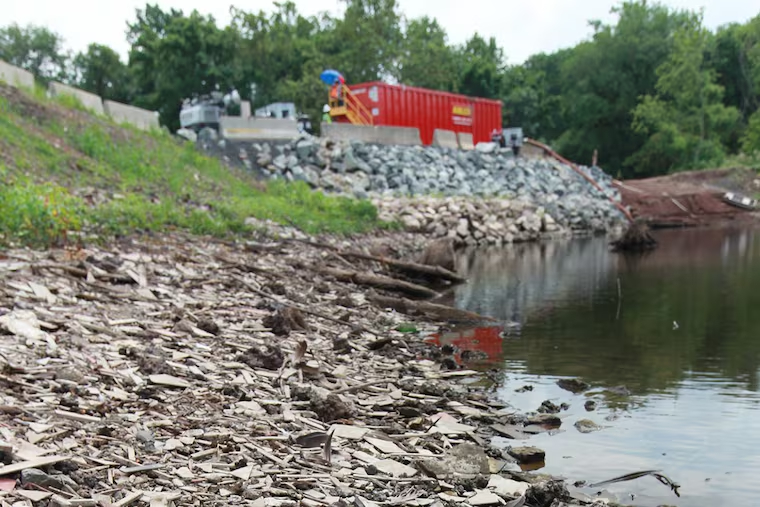EPA: 4 Philly-area Superfund sites among top in nation for development potential
The sites are among 31 Superfund sites nationwide the agency says have potential to "become catalysts for economic growth and revitalization." All are in various stages of cleanup.

Acres of entombed asbestos, a salvage yard, contaminated quarries, and a legendary steel mill are among area Superfund sites targeted by the Environmental Protection Agency as having the most redevelopment potential in the nation.
The four sites in Philadelphia, its suburbs and South Jersey are among 31 Superfund sites nationwide the agency said this week could "become catalysts for economic growth and revitalization." In all, there are 1,737 Superfund sites in the nation.
All of the local sites on the EPA's list are in advanced stages of cleanup and monitoring and are already being developed or are planned for new projects.
Redevelopment of Superfund sites is not new. However, EPA Administrator Scott Pruitt plans to make redevelopment a priority and established a Superfund Task Force — even though the Trump administration wants to slash the program's budget. The list was compiled as part of the task force's duties.
"EPA will work diligently with developers interested in reusing these and other Superfund sites," the agency said in a statement. The EPA said it also will reach out to community groups for input.
Jeff Tittel, director of New Jersey's Sierra Club, said he is all for appropriate redevelopment. But he said Pruitt seems to be in a rush to remove Superfund sites from the National Priorities List, which are those still in need of cleanup or attention.
"Will they actually be making sure the sites are fully cleaned up?" Tittel asked. "We're concerned there will be shortcuts, capping, and pave-and-waving rather than thorough environment remedies."
Still, he said in reference to one of the sites, the old Roebling Steel property, redevelopment "is making lemonade out of lemons and we support it, if done correctly."
The four local Superfund sites:
» READ MORE: Metal Bank
Spanning 10 acres on Milnor Street in Northeast Philadelphia, just off the Delaware River, the former scrap metal and transformer salvage business drained oil onto the property, contaminating it. Cleanup was declared complete in 2010 but it is still being monitored for signs of pollution. Revolution Recovery, which owns an adjoining parcel, bought property at the Metal Bank site to expand its operation. A nonprofit arts organization is already operating at the site. But acres remain that could be redeveloped, said EPA spokesman Roy Seneca.
» READ MORE: BoRit
Occupying 32 acres in Ambler Borough and Whitpain and Upper Dublin Townships in Montgomery County, BoRit contains a six-acre, 25-foot-high tomb for asbestos off Wissahickon and Prophecy Creeks that has been capped. The site comprises three parcels, one of which is now a reservoir used as a waterfowl preserve, a potential park, and the asbestos pile. It is one of 14 area Superfund sites within a flood or sea rise zone, meaning that it poses a greater potential hazard in a hurricane or large storm.
Roman Pronczak, administrator for Whitpain Township, said municipal officials are already hoping to build a community center, park and recreation facility on the portion of the BoRit site that falls within the township's borders. He said nearly all of the cleanup is complete.
"The tricky part is going to be how to build something that doesn't penetrate the cap that was placed over the asbestos," he said.
» READ MORE: Crater Resources
Occupying 50 acres in Upper Merion, Montgomery County, the site was used from 1919 through 1980 by Alan Wood Steel Co. and Keystone Coke Co., which dumped waste from coke production in quarries. Remediation started in 2009 and is ongoing, but a portion of the site already holds Renaissance Park, an office development.
Recently, the the EPA modified a cleanup plan to allow homes to be built elsewhere on the site.
» READ MORE: Roebling Steel Co.
At 200 acres, this Superfund site in Florence, Burlington County, is the largest on the local list. Steel wire and cables were made there until the 1980s, contaminating soil and groundwater. The Roebling family, which owned the site, was famed for building the Brooklyn Bridge. The site has been undergoing cleanup, including soil removal, for years. New Jersey Transit leases part of the site for a light-rail commuter station and parking lot. There is also a museum devoted to the Roeblings' role in the steel industry.
Richard Brook, administrator for Florence Township, said being on the list sends a positive message.
"I think what it's saying is that the EPA is letting developers know we are receptive," Brook said.
About 100 acres are still open for development; the township is in talks with Kampack, Inc., a packaging manufacturer, to use 43 acres.